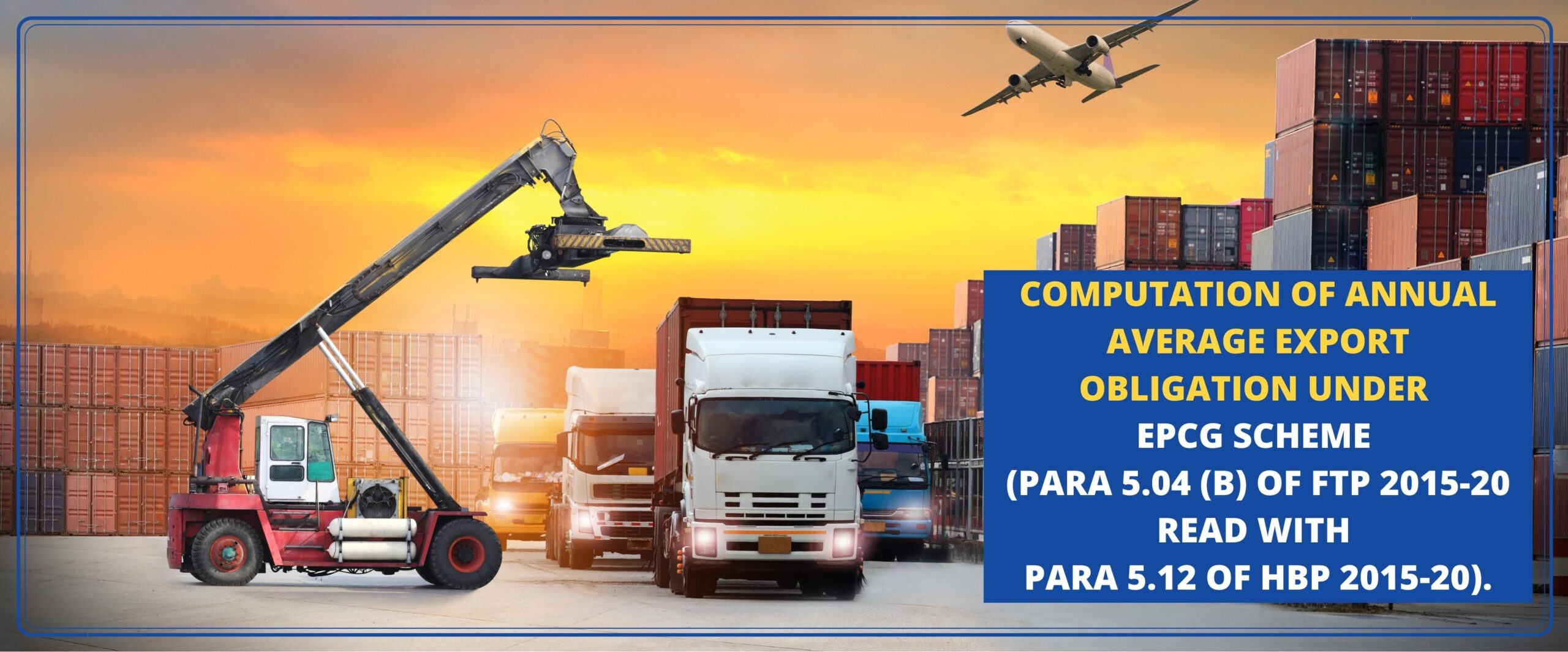COMPUTATION OF ANNUAL AVERAGE EXPORT OBLIGATION UNDER EPCG SCHEME (PARA 5.04 (b) OF FOREIGN TRADE POLICY 2015-20 READ WITH PARA 5.12 OF HBP 2015-20).

Introduction
You can easily find all the details about the computation of annual export obligation under Export Promotion Capital Goods (EPCG) Scheme in Para 5.04 (b) of Foreign Trade Policy (2015-2020) read with para 5.12 of HBP 2015-20.
The average export obligation under EPCG scheme shall be fixed as under: –
As per the EPCG authorizations that are issued to an applicant during the period of the licensing year, the average export obligation will be considered the same for products that are the same or somewhat similar in nature.
Exports made in the previous three years which are counted / being counted for fulfillment of specification export obligation within valid EO period (whether original or extended) will not be taken into account for calculating the average export obligation.
If an applicant has been in the existence for more than 3 years, then the exports, in each of the past 3 years (even if for some years, it may be zero) are aggregated and the aggregate export is divided by 3.
On the other hand, if an applicant has been in the existence for a time span of less than 3 years, then in that case the denomination that comes out from the above calculation will end up being the number of years and not 3.
The following table illustrates the fixation of average Export Obligation (in case a firm/company has applied for EPCG authorizations in the year 2021-22)
| Firm/Company in existence for more than 1 year but less than 2 years | |||
| Year 1 (2020-21) | Year 2 (2019-20) | Average Export
Obligation |
|
| Exports | NIL | Not Applicable | NIL |
| X | Not Applicable | X/1 | |
| Firm/Company In existence for more than 2 year but less than 3 years | |||
| Year 1 (2020-21) | Year 2 (2019-20) | Average Export
Obligation |
|
| Exports | NIL | NIL | NIL |
| NIL | X | X/2 | |
| X | Y | (X+Y)/2 | |
Let’s take an example of a firm or a company that has been in existence for a span of more than one year but less than two years, then the exports of the company in the second year will not be applicable.
If we think about the other situation such as a company or a firm that has been in the existence for a span of more than 2 years but less than 3 years, then the export of both the years will be counted by the licensing authority.
What is mentioned in Appendix 5F?
Certain capital goods have received the green signal from the side of the licensing authority and there are a few goods that have not been found suitable for the procedure of import under the EPCG Scheme.
Let’s take a trip down the memory lane of capital goods that are permitted and goods that are not permitted. First and foremost, we can pay attention to the capital goods that have received the approval of the licensing authority. They are as follows:
• Cables (it’s only permitted when it is a part of capital goods)
• Trucks, tippers, dumpers and. spares and that too of including tyres. The import of these kinds of capital goods is only allowed for the mining sector.
• Furniture, carpets, crockery, marble, chandelier, tiles, flooring, doors for rooms, fixing panels. These capital goods can only be imported by the hotel industry.
• Construction equipment viz. Cranes etc is also permitted by the authorities only for providing services.
Now, we can check out the goods and services that could not seek the approval of the licensing authority.
• Railway wagons (excluding specialized wagons) and tractors have not got the token of approval by DGFT.
• All capital goods such as Motor Cars, Sports Utility Vehicles and All purpose vehicles are not allowed for import under the EPCG Scheme.
• When we ponder about Airport Ground Handling Equipments, they also didn’t get the nod of the authorities.
• All construction material like sheds, cement, and steel is also not permitted for import by DGFT.
• Computers and printers didn’t receive the yes from the side of authorities.
• Capital Goods (including Captive plants and Power Generator Sets of any kind) for export of electrical energy (power): Supply of electrical energy (power) under Chapter 7; Supply of power (energy) in their own unit, and Supply/export of electricity transmission services are also not allowed for import under the EPCG Scheme.
Best DGFT Consultants in Hyderabad
Authors Bio:-

